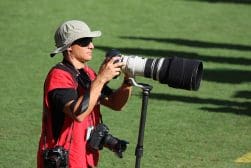



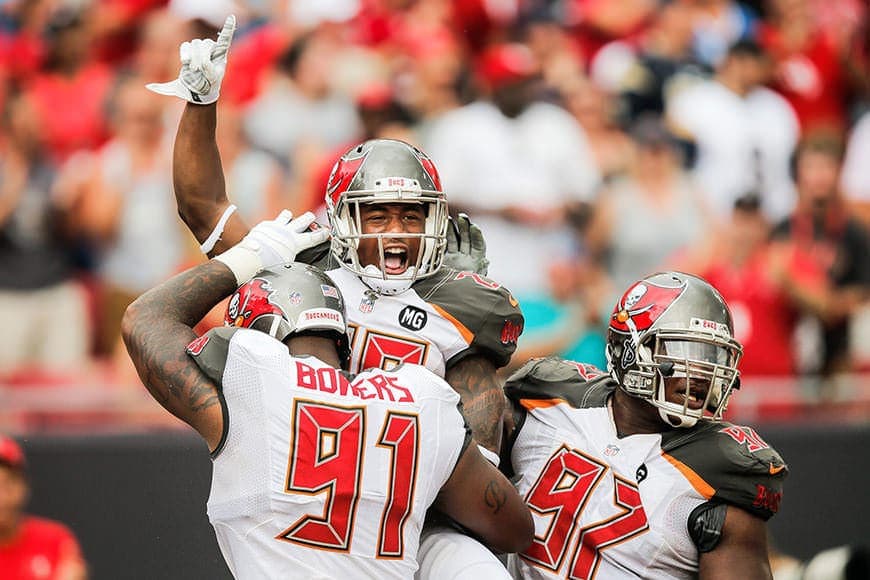
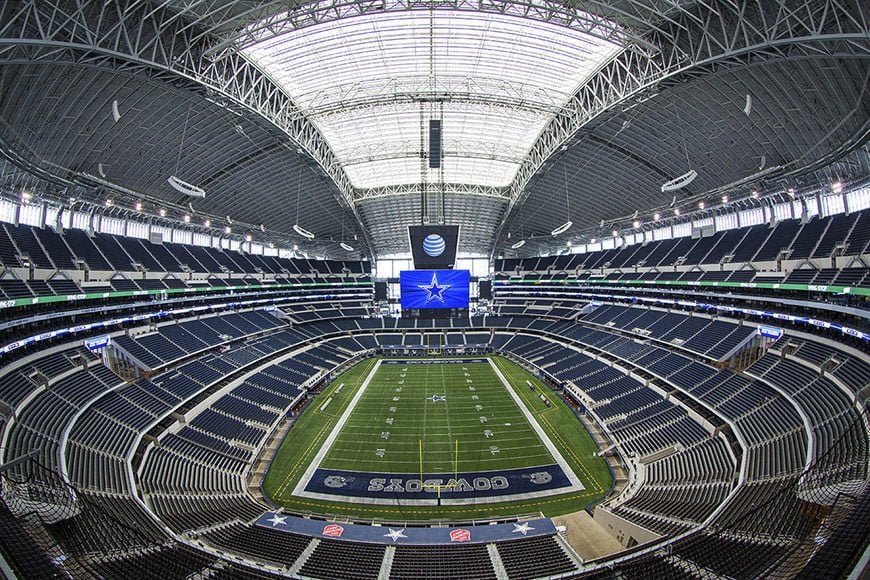


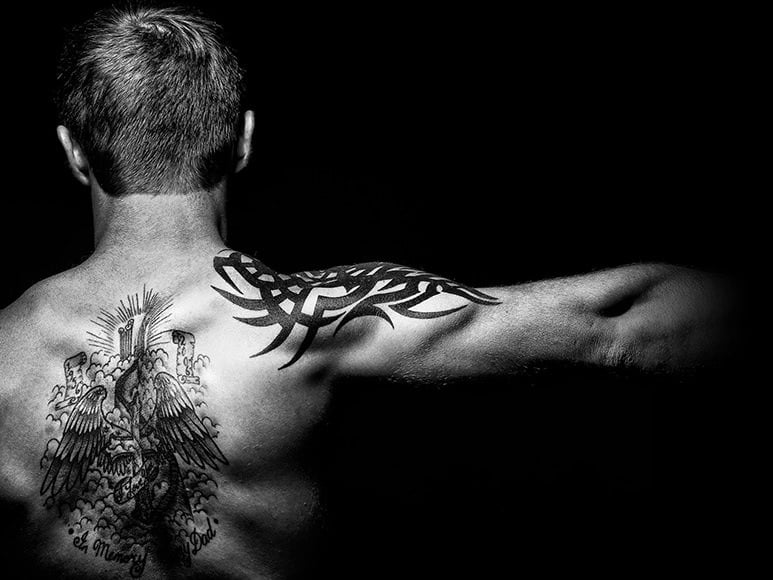





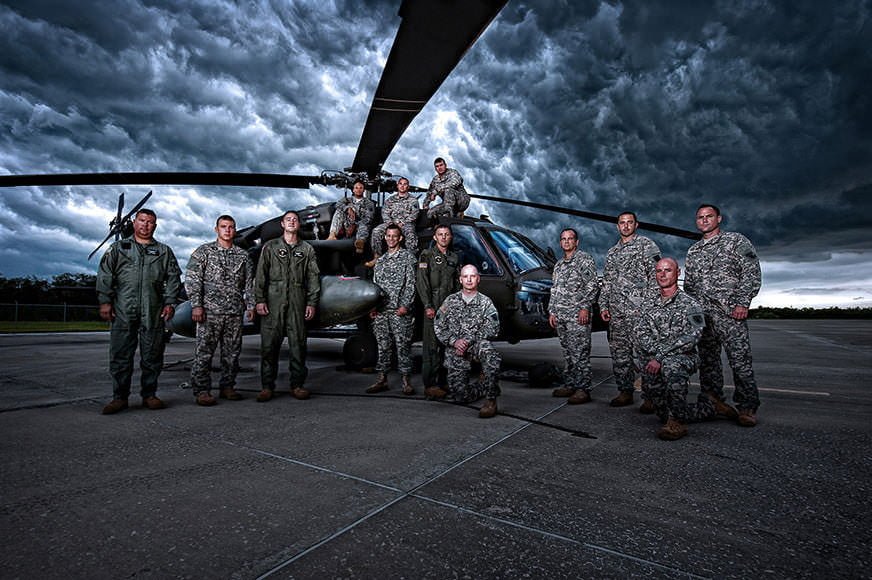
I actually use three different load-outs for the three different types of photography I do on a regular basis: (1) Sports Photography (2) Portraits and (3) Travel. Luckily, there’s a lot of overlap between the three, thanks to the fact that sports photography requires just a whole bunch of gear and once you have all that it helps with your other types of shoots as well.
We’ll start with sports photography.
(1) Sports Photography Loadout
When you’re shooting a fast-moving sport, most of the time you don’t have time to switch lenses so you switch camera bodies instead. Most of the shooters I run into an event are using at least two if not three bodies. I’m a two-body guy myself, and so I use two Canon 1Dx bodies.
These puppies were made for shooting sports and they are, hands down, the best I’ve ever used. They crank off 12-frames per second and I can shoot a night game or indoor game with those at up to 4,000 ISO (sometimes higher) and you don’t really see the noise, so they’re pretty amazing.
I do a lot of remote camera work for NFL games, so sometimes I need a third (or fourth) body, so I add my Canon 5D Mark III for those instances as well. They’re not pictured here (because I usually carry my remote stuff in a rolling Pelican case), but I use two f-plates (floor mounted stands) with Really Right Stuff ballheads on top and then each gets a PocketWizard Plus III wireless transmitter so I can fire them remotely.
For lenses, I have to use really long glass (the photographer who gets tightest in, wins), so my go-to lenses are my Canon 400mm f/2.8 or my Canon 200-400mm f/4 zoom with a built-in 1.4 tele-extender.
I use the Canon 400mm f/2.8 for night games because that extra stop of light makes a big difference in how low I can keep my ISO – even though it shoots amazingly well at high ISO, the images look even better if you don’t have to shoot at a high ISO, and on an NFL field, the difference between an f/2.8 lens and an f/4 is literally this: I can shoot at 1,600 ISO in a well-lit stadium at f/2.8. If I have to go to f/4, then I’m at 4,000 ISO. That’s a pretty big difference.
So, for day games I often use the Canon 200-400mm f/4 (if I turn on the 1.4 tele, it makes my lowest wide-open f/stop f/5.6 which is too high for a night or indoor game).
So, on game day, one of those two lenses is on my main body. I support my main lens using a nice thick Gitzo GM5541 6X Carbon Fiber Monopod, which I got as a gift from Gitzo after Green Bay Quarterback Aaron Rogers broke mine (while crashing into me) during the NFC Championship game in Chicago a few years ago.
On my second body I generally use the Canon 70-200 mm f/2.8. It’s crazy sharp and any time the team is inside the 20-yard line it’s a perfect go to lens. The other two lenses, my Canon 8-15mm f/4 fisheye and my Canon 16-35mm f/2.8 are mostly used on my remote camera for the player intros (as they take the field through a wall of smoke and pyrotechnics).
I carry around my 2nd camera body and Canon 70-200 mm f/2.8 using a Black Rapid RS-7 strap which goes across your body which is great because it’s faster to bring the camera to your eye, and it doesn’t fall off your shoulder as you’re running up and down the sidelines.
I also use that Hoodman Loupe so I can see the LCD screen during day games (it’s so bright out there you can’t see much, and I have to tag the best images while I’m out there on the field, so I can upload them quickly to the sports wire at halftime and immediately after the game).
(2) Portrait Photography Loadout
I have my own studio and I probably shoot the most in there, but I also do a lot of location work which is why you see the two Canon speed lights. I have a ton of accessories for them (everything from grids to gels to snoots and diffusers, etc. but I didn’t want to junk up the picture of my gear with all that stuff so we left it out). My go-to lens for my portrait work is definitely my Canon 70-200 mm f/2.8 and I usually out between 150mm to 200mm because I think the compression and perspective are much more flattering to my subjects. Plus, it gives them a little breathing room.
I also have an Canon 85mm f/1.2 lens that I generally only use for location work (for outdoor portraits or bridal shoots) and I have a Canon 24-70mm f/2.8 that honestly, we mostly use for behind-the-scenes and production shots. I not a big fan of the 24-70mm focal range. I like the 24mm, I hate the 70mm part, but I don’t like either for portraits. The distortion is just not very flattering.
I know Joe McNally uses the 24-70mm very successfully, but it’s like I’m reminded every time I do a shoot — I’m not Joe McNally. That guy is a magical unicorn and I don’t think they’ve made a lens he can’t coax an amazing photo out of, but so far, the Canon 24-70mm f/2.8 has been my nemesis so I just use it for production shots for the most part.
As for bodies, I’ll either take the Canon 5D Mark III (my most likely choice) or the Canon 1Dx if we’re shooting late in the day or at night, so I get the advantage of little better high ISO performance, but honestly the Canon 5D Mark III is pretty darn good.
(3) Travel Photography Loadout
I’ve done travel rolling “big,” taking two bags of rolling gear, and I’ve done it really simple and lightweight, and simple and lightweight wins every time — I literally take one body (the Canon 5D Mark III) and one lens (which as I write this, I realize that it’s not in the photo) my Tamron 28-300mm f/3.5 – f/5.6. It’s one lens that does it all. It’s not going to win any awards for sharpness (it’s only nearly as sharp, for example, as the Nikon 28-300mm f/3.5-5.6 which is awesomely sharp), but it’s so much lighter, smaller and less expensive than the Canon version (which if you ask me is not made for travel on any level) – I had to go with it.
I use the Black Rapid RSD-1BB for walking around (for safety – since it’s strapped across your body – it’s not easy to snatch it and grab it. In fact, it’s about impossible, because if you grab it and start running off, I’m going with it. Very slowly I might add. LOL!). Plus, it’s ready to shoot in a moments notice since it sits at your side like your camera is in a holster – you just pick it up and shoot – no taking it off your shoulder first.
I also usually take the Hoodman Loupe so I can see when shooting travel outdoors. That’s it. A simple set-up: one body, one lens, a camera strap and some Lexar Compact Flash Cards (and an SD card for backups as I shoot).
So, there you have my three basic loadouts. Sadly, (especially for my full-time assistant, Brad Moore) I have a bunch more gear, including more bodies, lenses, studio lighting, accessories, but I just wanted to share my main daily-use stuff here.
Here’s a full list of my current gear:
Cameras
Canon 5D Mark III
Canon 1Dx
Canon 7d Mark II
Canon 70d
Lenses
Canon 8-15mm f/4L fisheye
Canon 11-24mm f/4L
Canon 14mm f/2.8L II
Canon 16-35mm f/2.8
Canon 24-70mm f/2.8 II
Canon 24-105mm f/4L
Canon 70-200mm f/2.8L IS II
Canon 300mm f/2.8L IS II USM
Canon 200-400mm f/4L
Canon 400mm f/2.8L
Canon 1.4x EF III Teleconverter
Other
Really Right Stuff “L” Brackets
Black Rapid RS-7 Strap
UpStrap Quick Release Camera Strap
3.2” Hoodman Compact HoodLoupe
ThinkTank Hydrophobia 70-200
ThinkTank Hydrophobia 300-600
Op/Tech RainSleeve
TetherTools JerkStopper Camera Support

Check out these 8 essential tools to help you succeed as a professional photographer.
Includes limited-time discounts.








